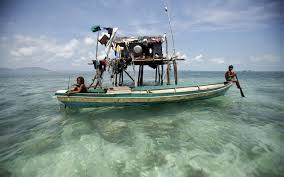CHINA’S HISTORIC RIGHTS TO OCEANS AND PLATEAUS
First, we had the “Washington consensus” of the 1990s, a convergence of “well-known facts” about the inevitable triumph of capitalism, after the dissolution of the Soviet Union and the end of the Cold War. The Washington Consensus on the superiority of neoliberal capitalism coincided, not coincidentally, with the boom in billionaire wealth creation and the stagnation of the American middle class, while the poor got left further behind. Today the inequality gap is the driver of the US 2016 presidential election, and the Washington consensus, which lasted at most for a decade, seems like a silly collective hallucination.
But it also set off a fad for consensuses of all sorts. We soon got the Beijing Consensus aka the China Model, a state capitalist alternative to the Washington model. Only that was back in 2004, when China was none too keen on proclaiming its developmentalist, statist system a model for anyone else, back in the days when China was determined to keep its head down, grow as fast as possible, and maintain a low profile. China then, so unlike today, didn’t want to be seen as exemplary, or a paragon for others to emulate. So, in the absence of it being championed by China, the Beijing Consensus quickly faded from view.
Now we have the “Lhasa Consensus”, very much a Chinese invention. Like the previous Consensuses, it is all about development, growth, progress and modernity, though without any suggestion that this is a model that fits anyone but the Tibetans. Actually, it covers only half of the Tibetans, not the other half who live in nominally autonomous Tibetan prefectures in Chinese provinces outside the Tibet Autonomous Region or TAR.
Consensuses aren’t what they used to be. The Lhasa Consensus is merely 130 guests of the Chinese government who came to Lhasa for a few days and allowed their names to be used to validate the issuing of a “Lhasa Consensus” document drafted in advance by propaganda officials. The guest list included the Asia Society’s senior fundraiser, and Dan Dudek, “one of the world’s leading experts on market-based policies to reduce pollution at the least cost”, according to his employer. Another guest sitting in judgement on China’s model of development in TAR was Markus Rudolf, who, on his website, declares himself expert on Congo, Gambia, Guinea-Bissau, Iraq, Mali and Senegal, but not China. He is also an expert in corporate customer value metrics and bank capital adequacy ratios. China has now elevated him to “China issue expert”, thus making him at once an expert also on Tibet.
These three are the most prominently featured in China’s Lhasa Consensus media coverage. Their collective judgement of Tibet, meaning TAR, was that all is well, and in line with well-known laws of history and norms of development. In the words of the Lhasa Consensus: “The new development concepts of innovative, coordinated, green, open and shared development are in line with the times and the norms of development. The concepts are also of great importance in guiding Tibet’s future development. The concept of innovation will lead Tibet on a path of scientific and technological progress, and the concept of coordination will lead the region on a path of sustainable development. The concept of green development will help Tibet in environmental protection, and the concept of openness will promote modern civilization in Tibet. The concept of shared development will steer Tibet toward common prosperity. The development of Tibet is standing at a new historic starting point.”
This is exactly the line taken by successive Chinese Government White Papers on Tibet, which emphasize that Tibet, under the benevolent guidance of the Chinese Communist Party, is following the laws of development.
IS TIBET DEVELOPING NORMALLY?
An alternative viewpoint comes from the in-depth fieldwork in Tibet done by Chinese economists and anthropologists, who argue that what China has done is to create deep dependence in Tibet, on central funding that endlessly subsidises a Han immigrant urban elite, while widening the gap with the overwhelmingly Tibetan rural poor. These Chinese economists and social scientists, writing their doctoral dissertations about the sonderweg development path unique to TAR, might be considered the real experts.
Among them are Ma Rong, Sun Yong,[1] Yu Yungui,[2] Wang Luolin,[3] Lu Minglun,[4] Zhou Daming[5] and Jin Wei.
They show that, far from a “normal” approach to development economics, emphasizing comparative advantage, factor endowments and the opportunity to add value to pastoral production, China instead ignored rural Tibet and invested all its massive capital expenditure on enclaves of intensive development: mines, hydro dams, power lines, highways, railways, pipelines, urban centres. This guaranteed employment for immigrant Han Chinese, clustered in the enclaves, earning high salaries paid by the central state, to run a security state fixated on grid management and other strategies for controlling the Tibetans, who were and are largely excluded from free movement of labour and economic opportunity. Far from being a standard model of development, China has ignored DevEcon101 and imposed a new economy, dominated by the tertiary sector of administrators and security personnel. China failed to develop the production landscapes of Tibetan primary industry, or secondary industries processing and adding value to what Tibetans are so good at, which is livestock production. Tibet’s deepening dependence, with so little return to show for it, is a travesty of development.
Why does China so determinedly ignore its own economists and stick to its path dependence on endlessly repeating the same mistakes, which only further alienate the Tibetans? To try to answer that, we might first deviate, to another announcement of recent days, the UN Convention of the Law of the Sea (UNCLOS) ruling on China’s claim to historic ownership of the seas well to the south of China.
 Just a few days after the Lhasa Consensus came and went, international law issued its definitive arbitral decision. As The Guardian put it: “After three years of nail-biting anticipation, the Philippines has scored a historic legal victory against China in the South China Sea. An international tribunal handed the Philippines a virtual clean sweep in a landmark case that could define not only the trajectory of the maritime disputes in the area but also the broader international order. Most observers expected a favourable outcome for the Philippines, but no one knew to what extent. To the surprise of many legal experts, the tribunal not only exercised jurisdiction on the most sensitive items of the Philippines’ case but it issued favourable judgment on the merits of almost all of the south-east Asian country’s arguments. According to the tribunal, China’s doctrine of “historic rights”, which undergirds its sweeping nine-dash line claim, was incompatible with prevailing international law and “there was no evidence that China had historically exercised exclusive control over the waters or their resources”.
Just a few days after the Lhasa Consensus came and went, international law issued its definitive arbitral decision. As The Guardian put it: “After three years of nail-biting anticipation, the Philippines has scored a historic legal victory against China in the South China Sea. An international tribunal handed the Philippines a virtual clean sweep in a landmark case that could define not only the trajectory of the maritime disputes in the area but also the broader international order. Most observers expected a favourable outcome for the Philippines, but no one knew to what extent. To the surprise of many legal experts, the tribunal not only exercised jurisdiction on the most sensitive items of the Philippines’ case but it issued favourable judgment on the merits of almost all of the south-east Asian country’s arguments. According to the tribunal, China’s doctrine of “historic rights”, which undergirds its sweeping nine-dash line claim, was incompatible with prevailing international law and “there was no evidence that China had historically exercised exclusive control over the waters or their resources”.
China has long argued that it is fully entitled to consider Tibet to be China’s, on the same grounds, of historic ownership. The debate over this has dragged on for decades, obscured by Qing dynasty edicts, ambiguous relations between Dalai Lamas and Chinese Emperors, British imperial doctrines of suzerainty, to the bafflement and boredom of all but the most committed of lawyers. Tibet’s position in international law remains unresolved.
What the UNCLOS ruling achieves is to remind us that all the talk of “China’s Tibet” as a historic fact has no meaning in international law unless that claim is backed by facts on the ground, by the ongoing presence of the state, in the lives of the population. Legal disputation about ownership only gets you so far. Ruling a few islands or a few enclaves only gets you so far. What really counts is whether China has historically been the only government of Tibet, to the exclusion of all other governments, with a real day-to-day presence in Tibetan lives.
Not even the most zealous of proponents of “China’s Tibet” claim that Tibet was under administrative control of China, with a Chinese government presence in each town, village and nomad encampment, even if only to extract taxes. Not until the 1950s did China manifest any actual control, across the land. Likewise, Chinese fishermen may have come and gone fishing throughout the seas to the south of China, but that does not establish exclusive sovereignty over both the islands and the entire high seas China now claims.
HISTORIC RIGHTS FORMALLY ADJUDICATED
Few have read much of the 501 pages of the UNCLOS ruling. For Tibetans, it is worth a closer look.
It is worth quoting key sections: “In 1962, following the Second UN Conference on the Law of the Sea, the UN Secretariat produced a memorandum on historic waters, which considered the term as equivalent to historic title. The memorandum analyses the formation of historic title as a process of acquiring a historic right—a term which is used generally—and concludes that: In determining whether or not a title to “historic waters” exists, there are three factors which have to be taken into consideration, namely, (i) The authority exercised over the area by the State claiming it as “historic waters”; (ii) The continuity of such exercise of authority; (iii) The attitude of foreign States.” 95
“China has stated its view that its “relevant rights in the South China Sea, formed in the long historical course” are “protected under international law including the United Nations Convention on the Law of the Sea (UNCLOS).” Insofar as China’s relevant rights comprise a claim to historic rights to living and non-living resources within the ‘nine-dash line’, partially in areas that would otherwise comprise the exclusive economic zone or continental shelf of the Philippines, the Tribunal cannot agree with this position. The Convention does not include any express provisions preserving or protecting historic rights that are at variance with the Convention. On the contrary, the Convention supersedes earlier rights and agreements to the extent of any incompatibility. The Convention is comprehensive in setting out the nature of the exclusive economic zone and continental shelf and the rights of other States within those zones. China’s claim to historic rights is not compatible with these provisions.” 103
” According to China, its nationals have historically engaged in navigation and trade in the South China Sea and the activities of Chinese fishermen in residing, working, and living among the Spratly Islands “are all manifestly recorded in Geng Lu Bu (Manual of Sea Routes) which was passed down from generation to generation among Chinese fishermen.” 112 In the Tribunal’s view, however, much of this evidence—on both sides—has nothing to do with the question of whether China has historically had rights to living and non-living resources beyond the limits of the territorial sea in the South China Sea and therefore is irrelevant to the matters before this Tribunal.” 113
“The Tribunal recalls that the process for the formation of historic rights in international law…. requires the continuous exercise of the claimed right by the State asserting the claim and acquiescence on the part of other affected States. 113
“Accordingly, the scope of a claim to historic rights depends upon the scope of the acts that are carried out as the exercise of the claimed right. Evidence that either the Philippines or China had historically made use of the islands of the South China Sea would, at most, support a claim to historic rights to those islands. Evidence of use giving rise to historic rights with respect to the islands, however, would not establish historic rights to the waters beyond the territorial sea. The converse is also true: historic usage of the waters of the South China Sea cannot lead to rights with respect to the islands there. The two domains are distinct. 113
“The Tribunal notes that historic rights are, in most instances, exceptional rights. They accord a right that a State would not otherwise hold, were it not for the operation of the historical process giving rise to the right and the acquiescence of other States in the process. 113
“Historical navigation and fishing, beyond the territorial sea, cannot therefore form the basis for the emergence of a historic right. Evidence that merely points to even very intensive Chinese navigation and fishing in the South China Sea would be insufficient. Instead, in order to establish historic rights in the waters of the South China Sea, it would be necessary to show that China had engaged in activities that deviated from what was permitted under the freedom of the high seas and that other States acquiesced in such a right. In practice, to establish the exclusive historic right to living and non-living resources within the ‘nine-dash line’, which China now appears to claim, it would be necessary to show that China had historically sought to prohibit or restrict the exploitation of such resources by the nationals of other States and that those States had acquiesced in such restrictions. In the Tribunal’s view, such a claim cannot be supported. The Tribunal is unable to identify any evidence that would suggest that China historically regulated or controlled fishing in the South China Sea, beyond the limits of the territorial sea. “ 114
China’s “historic rights” to Tibet or the South China Sea are equally flimsy, only there is no treaty or international tribunal for land, as there is for the sea. But the argument remains fundamentally identical, and it is an argument familiar to land title lawyers around the world. In Australia, for example, Aboriginal claimants to native title can succeed in court only if they can prove, despite centuries of dispossession and discrimination, their unbroken and continuous use of their lands, right up to the present, especially for productive purposes.
China knows it never governed Tibet, and that remains its core dilemma. In order to assert itself as sovereign, it must deal with the unfinished business of the Qing Empire, which sent armies into Tibet but seldom established actual rule, with a manifest state presence in Tibetan lives. That has been the agenda of the past 65 years, and it remains an unfinished agenda. Turning an empire into a nation-state is not done overnight. It requires massive investment in the infrastructure of control, huge statist projects that establish the nation-state as exercising actual daily control over both the full territory it claims and over the lives of all it claims as its citizens.
Only if we understand this nation-building agenda can we understand why China failed to initiate the basics of development, which would have strengthened the wool and dairy industries of Tibet, and raised the incomes of even the most remote nomadic pastoralists. That is the last thing China wanted. Instead its agenda throughout has been to create employment for Han immigrants, by imposing an economy of tertiary industry administrators and security personnel, from above. That is why there are so few linkages between the Tibetan economy and the vast economy of lowland China, where there is great demand for Tibetans do best: dairy and wool. Right now, China gets its dairy products from huge corporate enterprises based in Inner Mongolia, New Zealand and Australia, not Tibet.
LHASA DISSENSUS
The Lhasa Consensus got it wrong. Tibet is not on a normal path of development, it is on a special path that disempowers ordinary Tibetans, herds them into fast growing concrete cantonments on urban fringes, their traditional livelihoods nullified by grazing bans, their entry into the urban economy blocked by strict limits on mobility, in the name of security.
Under the global Law of the Sea treaty, China has dramatically failed to win its “historic right” to huge areas of distant ocean. On land, in Tibet, its’ similar claim to “historic rights” to Tibet will continue to fail, and continue to alienate Tibetans reduced to dependence on state ration handouts, as long as China fails to develop Tibet with Tibetans the main beneficiaries.
To repeat: the UN Law of the Sea tribunal judgement says: “In determining whether or not a title to “historic waters” exists, there are three factors which have to be taken into consideration, namely, (i) The authority exercised over the area by the State claiming it as “historic waters”; (ii) The continuity of such exercise of authority; (iii) The attitude of foreign States.” 95
When China belatedly realised it would have to prove ongoing, continuous exercise of regulatory power it issued a maritime equivalent of the grazing bans imposed on the best pasture lands of Tibet. In the words of the UNCLOS Tribunal: “China’s declaration, in May 2012, of a “Summer Ban on Marine Fishing in the South China Sea Maritime Space,” in order to “protect and rationally utilise South China Sea fishery resources.” The announcement described the ban and the area in which it would apply as follows: All productive activity types, except for using single-layer gill net and line-fishing equipment, shall be prohibited from 16 May 12:00 p.m. until 1 August 12:00 p.m. in the South China Sea areas from 12º north latitude up to the “Common Boundary Line of Fujian-Guangdong Sea Areas” (including the Gulf of Tonkin) under the jurisdiction of the People’s Republic of China.” 88
As in Tibet, this ban, devised to prove China exercises effective control, is worded as if this is a rational, scientifically-based biodiversity conservation regulation. The intent is more basic: to show that China is in exclusive control.
There weren’t too many such environmental edicts. By 2012 China’s bulldozers, dredges, cranes and other heavy earth moving equipment were busy trashing the living coral reefs, to make land rise above the tide line. The time for making a show of environmetal protection had passed.
In order to insert the modern nation-state into traditionally stateless Tibetan regions, states can only do what states can do, which is to restrict, constrict, limit, extract, scrutinise and control that which never needed state control. At sea the invisible losers will be the Bajau Laut, the so-called nomads of the seas adjacent to the Philippines, whose pictures are throughout this blog. The losers on land are the Tibetan nomads, made scrutable to the state, only to be closed and their lands withdrawn from productive use, in order to assert the sovereignty of the nation-state.
China’s relentless insistence it is in exclusive control of Tibet reduces Tibetans to ever deeper dependence, and further strengthens Tibetan resolve to remain Tibetan, and resist assimilation. There may be no tribunal on earth to adjudicate China’s claim to Tibet, but on the ground China’s distorted version of development with Chinese characteristics is counter-productively bringing about what China most fears: ever deeper mistrust among Tibetans of becoming Chinese.
China is also triggering deepening mistrust elsewhere, by responding so truculently to the UNCLOS ruling, releasing, for example, a patriotic video warning everyone: “Don’t cause trouble in front of our house”, with missiles blazing in response.
[1]西藏:非典型二元结构下的发展改革 (孙勇等,中国藏学出版社,1991
[2]西藏产业 (俞允贵等,中国藏学出版社,1994
[3]市场化与基层公共服务 – 西藏案例研究 (王洛林等,民族出版社,2005
[4]西藏自治区发展与跨世纪产业结构调整 (吕鸣伦等,地理研究,1996〈4〉
[5]西藏经济发展两 (周大鸣,民族研究,1997[1]
One reply on “ALL AT SEA WITH THE LHASA CONSENSUS”
Well worth reading, thank you!